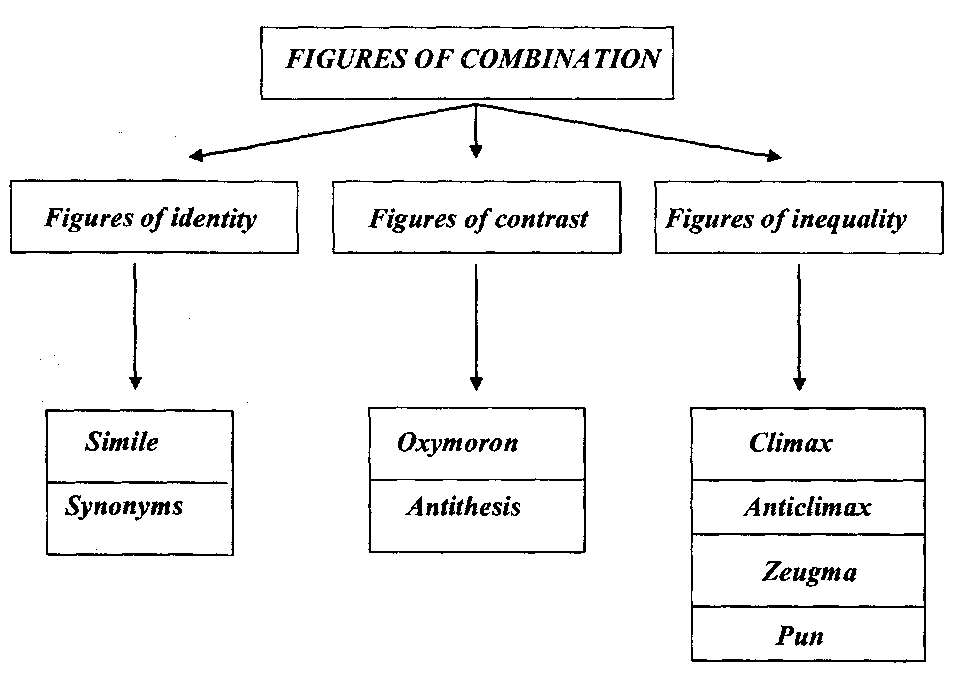
- •Lecture 7. Lexico-semantic stylistic devices: figures of combination
- •Figures of identity: simile, synonyms.
- •Figures of contrast: oxymoron, antithesis, paradox.
- •Figures of inequality: climax, anticlimax, zeugma, pun.
- •Figures of identity: simile, synonyms.
- •Figures of contrast: oxymoron, antithesis, paradox.
- •Figures of inequality: climax, anticlimax, zeugma, pun.
Lecture 7. Lexico-semantic stylistic devices: figures of combination
Figures of identity: simile, synonyms.
Figures of contrast: oxymoron, antithesis, paradox.
Figures of inequality: climax, anticlimax, zeugma, pun.

Figures of identity: simile, synonyms.
Simile (Lat similis = “alike”) is the figure of identity which consists in expressive comparison of two objects which have something in common. It is an imaginative comparison; simile is based on the comparison of objects belonging to entirely different classes of things., e.g., I felt as if I were in a monstrous spider’s web. Be thou as pure as snow.
Simile is one of the most frequent and effective means of making speech expressive. The more unexpected the confrontation of two objects is, the more expressive sounds simile. So, a raindrop can become a crystal, fear can become an abyss, and jealousy a monster. By employing imagery, we interpret the material world and use language to transmit our vision.
Simile should not be confused with logical comparison which is devoid of any stylistic meaning. The sentence "John can run as fast as Jack" contains purely logical confrontation of two objects. Here are some more examples of logical comparison:
John is older than Sam. John behaves like his father.
Словом, Яринка стала панночкою, як і її приятельки, сусідки з інших сіл. Іван Захарович знає це краще, ніж будь-хто.
Similes may have different structures. Most often they are introduced by conjunctions as, like, as if, as though, no better than, as… as, so … as:
Rosa is as beautiful as a flower. Paula is like a fairy.
Robin looked at Sibil as a mouse might look at a cat.
Viola behaves as if she were a child.
Conjunctions of comparison in the Ukrainian language are the following: як, мов, мовби, немов, немовби, наче, начебто, неначе, ніби, нібито, ніж, аніж, etc.:
Гули хрущі та літали, як кулі.
Обмок – як вовк, обкис – як біс, голодний – як собака.
Гаснуть вогні у місті, ніби в безодню моря падають зорі янтарні.
Ваша образа для мене гірше смерті.
Наполоханою пташкою кинулася Марія до сінешніх дверей.
Some similes are introduced by means of words denoting comparison: resemble, remind, suggest, seem. Or simile may be implied, having no formal indications of comparison, e.g., Odette had a strange resemblance to a captive bird.
Similes may be expressed by adjectives in the comparative degree or adverbial word-combinations containing prepositional attributes:
Roy behaved worse than a cutthroat.
With the quickness of a cat. Samuel climbed up the tree.
A great number of similes have lost their expressiveness because of long use, their wide usage in everyday speech, e.g., as brave as a lion, as busy as a bee.
• A simile requires less of an imaginative leap than does a metaphor. A simile states that A is like B, whereas a metaphor suggests that A actually is B.
• The simile is one component of imagery. This is the process of evoking ideas, people, places, feelings and various other connections in a vivid and effective way.
• Imagery is used in both written and spoken communication in many varieties of form, from advertising to poetry and from chatting to speech-making.
• Simile, metaphor and symbol are the main types of imagery, and the result is that communication acquires a creative and vital quality which somehow springs from the essential act of comparison.
Synonyms. The speaker resorts to synonymic nomination of the same notion due to a number of reasons which arise from the functions of synonyms in speech.
1. Compositional function. If the same word is repeated a number of times in a limited fragment of speech, the speech becomes clumsy, monotonous and stylistically crippled: John came into the room. John was excited. John threw himself into the arm-chair... The clumsiness is removed by means of contextual synonyms: John = he = the man = Sam's brother = the victim of the situation, etc. В кінці вулиці з'явився якийсь чоловік. Він чогось озирався назад і поспішав.
2. Specifying function. To describe the object in a thorough, profound and detailed way, the speaker composes a chain of synonymic words of the same syntactic function. E.g.:
Oswald's life was fading, fainting, gasping away, extinguishing slowly.
Edgar was such a scoundrel, such a blackguard, such a villain, such a rascal.
А яка вода в Основі! Лагідна, ласкава, м'яко-шовкова.
Зелений світ, вмитий росами, лящав, висвистував, видзвонював лунко, переливався розмаїтістю акордів, ладів і тонів.
3. Intensifying function. A chain of synonyms is an important means of expressing human feelings and emotions. Scores of subjective modal meanings may be rendered with the help of synonymic repetition: request, invitation, gratitude, gladness, impatience, certainty, hatred, irritation, disgust, horror, indignation, fury, etc. E.g.:
Could you leave me now, Rupert. I'm exhausted, tired, weary of the whole thing!
Kill him, Johnnie! Murder him! Slaughter him like a pig!
Вони знов давай його просить, давай його благати.
Ну й перелякався я, отетерів з ляку.
